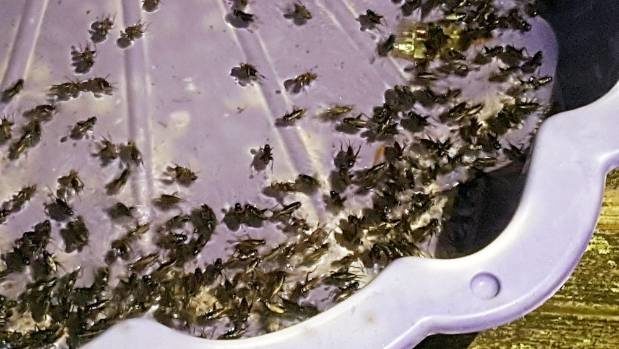
© Siobhan LemmeSiobhan Lemme snapped this photo of hundreds of crickets drowned in a paddling pool.
Sticky humidity isn't the only thing keeping rural residents up at night this week.
Crickets have arrived in their thousands "like a scary movie scene", and they aren't afraid of making a racket.
Some have had their homes invaded by the noisy insects, while others have experienced crickets pounding down on their rooves with a sound like heavy rain.
Steff and Bill Shepherd described a "cricket explosion" in Dargaville.
"The ground is alive with them late afternoon onwards. Some are sizeable, and ping on the roof and walls and windows," they said in a Neighbourly post.
"It's like small gravel thrown at the house."
Kaukapakapa resident Jessie Montgomery felt like her house was being "dive bombed" by the critters on February 12.
"Even on my way home in the car, I was wondering what bugs were constantly hitting my windscreen. The plague of crickets cometh," she said.
And Jackie Snijder spotted "thousands" at her home in rural Wellsford.
"The ground was black in front of the house and they were all jumping against my windows. [It] was like a scary movie scene," she said.
Aucklander John O'Brien says the "annoying" bugs are the only thing he clearly hears over his tinnitus.
While some find the noisy visitors to be frustrating, they have proved to be a delicious night time snack for furry family members.
Maungaturoto's Jennifer Langridge didn't enjoy finding her toilet full of crickets in the middle of the night, but her cats thoroughly enjoyed playing with the evening guests.
And meanwhile in Mahurangi, resident Alison Hewat's dog was "bewildered" yesterday morning by a slightly smaller breakfast than usual.
The German Shepherd had already enjoyed an evening catching and eating crickets.
In Netherton, in the Waikato, a resident used a leaf blower to get all the crickets out of the garage.
Auckland War Memorial Museum curator of entomology John Early says the reason for the surge in cricket numbers is likely due to the time of year and wet weather.
The end of summer is when crickets reach peak numbers, but heavy rain can flush the insects out from cracks in the ground, where they hide.
"I imagine the rain has been driving them out of their hidey holes and stirring them up, so they're more noticeable," he said.
Early says some years can see "mass flights" of crickets at night, but cannot confirm if that is the case this season.
Cricket eggs are laid in the soil, and tend to hatch in the springtime.
Once hatched, the crickets feed on grass, and shed their skins as they grow in size.
Their appetite can be destructive to pasture when they are in high numbers, Early said.
Source: Rodney Times

Reader Comments
to our Newsletter